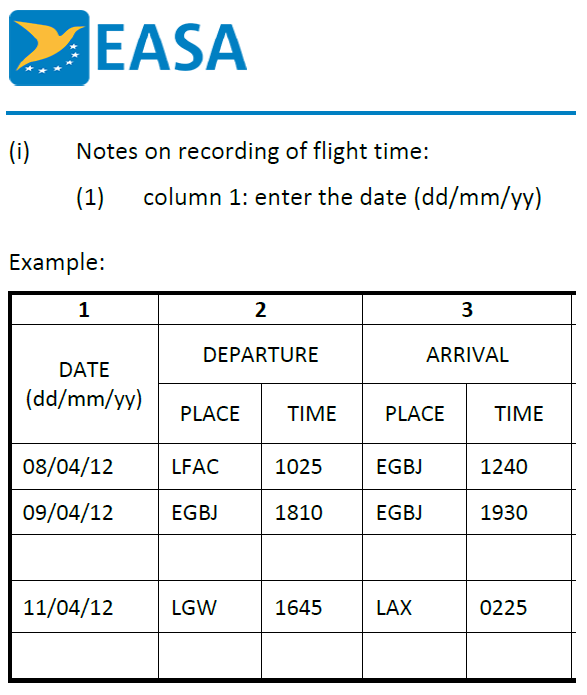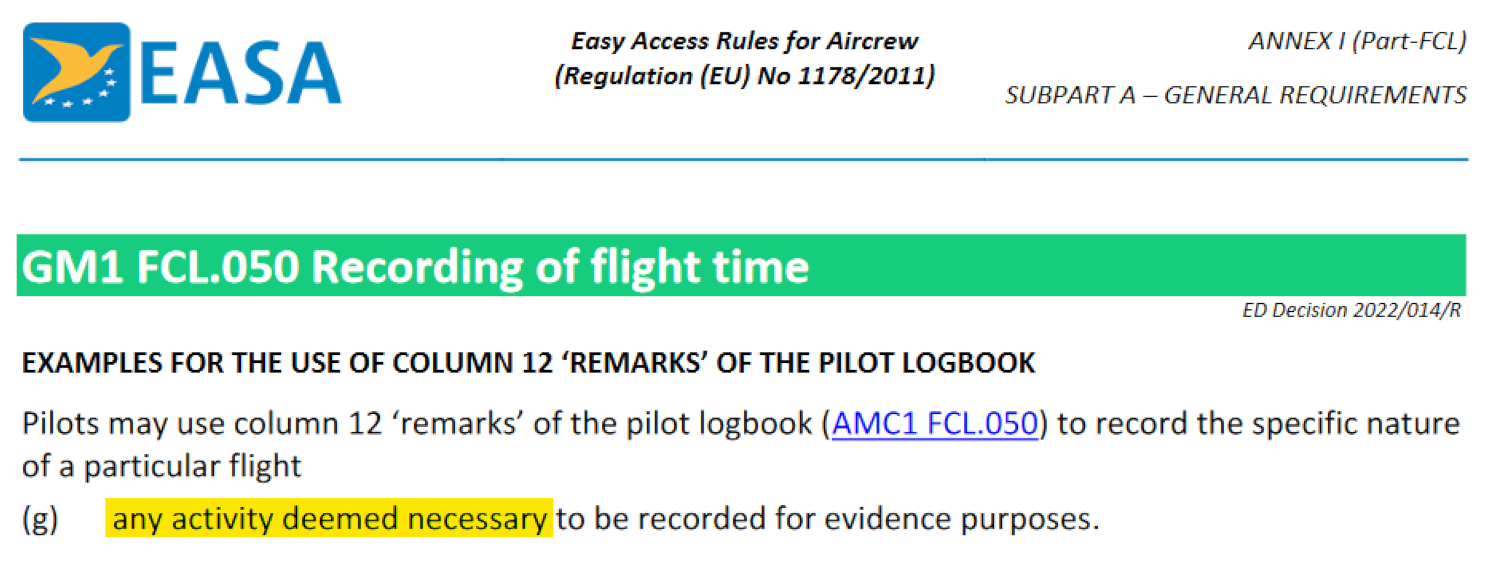General requirements for pilot logbooks from AMC1 FCL.050
General requirements
Unlike the requirements for digital pilot logbooks, these fundamental requirements are of a general nature and apply to all formats, i.e. paper books as well as digital ones, regardless of format and manufacturer.
For example, each data record must contain information about the date on which the flight or FSTD session took place. This is a very basic and generally applicable requirement.
Another, somewhat more specific example is the regulation of which pilot function shall instructors log and in which situation they may and may not record PIC time.
Both examples apply to all formats of logbooks and are therefore general requirements. The first is more broadly applicable because it applies to every entry, for every pilot. The second, on the other hand, only applies to a specific group of pilots and entries.

AMC1 FCL.050 (a) Minimum information of the flights flown
This section of AMC1 lists the values that are always required and must be recorded in the logbook for each flight. We have created an overview of the mandatory, optional and best practices to-be-recorded fields. This can be found on the page about how to keep a correct logbook.
AMC1 FCL.050 (b) Performed pilot function
This section of AMC1 outlines the rules for recording different types of flight time. Take a look at our dedicated glossary entry about recording of PIC time. The section covers recording Pilot in Command (PIC) time, including also in more specific scenarios like for solo flights, flights when acting under supervision, as an instructor, and or as an examiner. It also allows co-pilots to record PIC time under certain conditions, such as when acting as PIC under supervision (PICUS).
Additionally, the section describes logging co-pilot time for flights requiring multiple pilots, cruise relief co-pilot time, and instruction time if certified by an authorized instructor. It also includes provisions for recording PICUS (Pilot in Command Under Supervision) time, allowing co-pilots to record PIC time when performing all PIC duties without the need for intervention from the actual PIC.
There is a special case that allows several flights to be combined as a single flight logbook entry. This is called a series of flights and may only be used if several flights are carried out directly one after the other from the same location with less than 30 minutes in between.
AMC1 FCL.050 (c) Format of the record
This section of AMC1 specifies the format requirements for recording flight and FSTD details.
For flights in airplanes, helicopters, and powered-lift aircraft, pilots shall use a logbook format, which can be electronic, including all required data. For sailplanes, balloons, and airships, a format shall be used that includes the relevant information specific to these operations.
An important point that is regulated in this section is the clear separation of FSTD sessions. The session time must be recorded separately and may not be summed up together with the flight time.
This section of AMC1 specifies the format requirements for recording flight and FSTD details.
AMC1 FCL.050 (d) - (h)
Section (d) of AMC1 requires pilot licence holders to record details of all flights flown, using logbooks, to maintain a permanent record of their flying experience. Pilots who fly different aircraft categories, such as airplanes and helicopters, are advised to keep separate logbooks for each category.
According to Section (e), flight crew logbook entries should be made promptly after flights. Entries must be in ink or indelible pencil for paper records, or in a certified electronic format acceptable to authorities for electronic records. Section (f) mandates that flight details are to be recorded in appropriate logbook columns, allowing "series of flights" on the same day to be recorded as a single entry.
Section (g) specifies how flight time should be recorded for various aircraft types. Take a look at our dedicated glossary entry about the definition of Flight time for different aircraft categories. Section (h) states that in multi-pilot operations, one pilot must be designated as PIC by the operator before the flight, and this pilot then logs PIC Time. Flight time recorded as PICUS or SPIC must be certified by the PIC or an instructor, in case of paper logbooks, in the remarks column.
AMC1 FCL.050 (i)
While this section of AMC1 mainly repeats already mentioned points, there is also some interesting information between the lines. For example, it becomes clear that a distinction between SE and ME Time only needs to be made in single pilot operations.
The wording in this section also makes it clear that the entries should be made in UTC, which is also our recommendation, irrespective of where and what you fly. However, some pilots flying only regionally log entries in local time (LT) and the Competent Authorities accept these records in most cases.
AMC1 FCL.050 (i) (10) and GM1 FCL.050: Remark column 12
The section regarding the use of column 12 'remarks' in the pilot logbook provides certain examples of entries. This column can be used at the pilot's discretion to record flight details, but at the same time it requires certain entries, such as details of skill tests and proficiency checks or signatures from CMD or instructors.
The list of examples provided is by no means exhaustive and places the burden on the pilot to decide what to include. Even data required by other chapters of Part-FCL or other regulations like variant flown, flights in the role of examiner, to name a few, are not explicitly specified. This leads to inconsistent entries and variations in logbook records, making verification of experience difficult.
With the standardized Flight Markers from capzlog.aero, you ensure that all relevant information is uniformly recorded and can be evaluated. This makes your flight logbook bulletproof for official and operational purposes.

Implicit requirements
Some of the fields to be recorded are listed explicitly in AMC1 FCL.050 Recording of flight time. In addition, there are a number of data elements that are implicitly defined by conditions and requirements in Part-FCL, Part-SPO, Part-SPA, Part-ORO, Part-NCC, Part-NCO and Part-CAT.
Already within AMC1 FCL.050 there are major inconsistencies. For example, to comply with the basic PAX recency in accordance with FCL.060 one has to count take-offs, approaches and landings on aircraft or FSTDs. At the same time, however, it is not mentioned anywhere that landings on FSTD sessions are to be recorded.
Another example is the crediting of experience values when revalidating class ratings. For example, holders of a SEP (Land) and a SEP (Sea) class rating can cross-credit certain values such as flight time, take-offs and landings from the two categories against each other. However, this is not possible without a clear definition of how, for example, the flight time of a flight that takes off from land and lands on water is to be categorised and recorded and how the time is to be allocated to the class ratings.
A third example is the need for instructors to prove having supervised at least 25 solo flights in order to get the privilege to authorize student pilots to conduct first solo flights. The FI with restricted privileges has to track and prove the number of supervised solo flights.
In Part-SPO there are various operations for which the pilot must fulfil a certain recency. The required values are often formulated very specifically in the condition. However, the authorities are happy to leave it to the pilot to evaluate the conditions if no data is available, because there is no mention anywhere that this data has to be collected at all.
In the regulations for commercial operations, especially in multi-pilot operations, a whole range of additional values must be taken into account that have not been considered in the explicit format shown. These include, for example, the information that must be recorded in connection with LIFUS, OPC, LPC, EBT or in augmented crews. The same is valid for helicopter operations, where the requirements for keeping track of cycles, day and night operations, cargo vs person operations, rope lengths, mountain operations, etc. are not defined in any way in AMC1.
Do airline pilots need to keep a personal logbook?
Yes, despite widespread misconceptions about responsibilities, we are still not aware of a single operator who officially assumes responsibility for keeping their pilots' logbooks. Read more about pilot logbooks for airline pilots.
The specialists and experts at capzlog.aero constantly monitor and process the information from the regulations so that you always have the right information to hand when you need it - directly in your digital logbook.
Commission regulation (EU) No 1178/2011 (Air crew) incl. 2018/395 & 2018/1976
- Part-FCL - Flight Crew Licencing
- Part-SFCL - Sailplane Flight Crew Licencing
- Part-BFCL - Balloon Flight Crew Licencing
Commission regulation (EU) No 965/2012 (Air operations)
- Part-SPO - Specialised Operations
- Part-SPA - Specific Approvals
- Part-ORO - Organisation Requirements for Air Operations
- Part-NCC - Non-commercial operations with complex-motor-powered aircraft
- Part-NCO - Non-commercial operations with other than complex-motor-powered aircraft
- Part-CAT - Commercial Air Transport Operations
Signatures
Certain entries in the pilot logbook must be signed in accordance with the specifications. However, this applies to far fewer situations than is widely assumed.
Here, too, one has to read various regulations to figure out which entries have to be countersigned. In practice, there are also DTOs and ATOs that define and implement their own, more extensive requirements in addition to the FCL specifications.
For the sake of completeness, we have listed below the explicit mentions of signatures in AMC1 FCL.050 (original English language):
- AMC1 FCL.050 (b) (1) (ii) the applicant for, or holder of, a pilot licence may log as PIC time all solo flight time, flight time as SPIC and flight time under supervision provided that such SPIC time and flight time under supervision are countersigned by the instructor;
- AMC1 FCL.050 (b) (1) (v) a co-pilot acting as PICUS on an aircraft on which more than one pilot is required under the type certification of the aircraft or as required by operational requirements provided that such PICUS time is countersigned by the PIC;
- AMC1 FCL.050 (i) (8) (ii) SPIC/PICUS countersigned by PIC/FI in remarks column
- AMC1 FCL.050 (i) (10) (iv) name and signature of instructor if flight is part of an SEP or TMG class rating revalidation;
- AMC1 FCL.050 (i) (10) (v) for multi-pilot operations in single-pilot helicopters, the form of operation, name and signature of the examiner conducting the skill test or proficiency check or operator proficiency check, and the name of the operator in the case of the operator proficiency check.
- AMC1 FCL.135.A and H LAPL(A) (b) In order to extend the privileges to another variant within a class, the pilot shall either undertake differences training or do a familiarisation. The differences training shall be entered in the pilot’s logbook or into an equivalent record and be signed by the instructor.
- AMC1 FCL.710.A (e) The differences training or the proficiency check in that variant shall be entered in the pilots’ logbook or equivalent record and signed by the instructor or examiner as appropriate.
- AMC1 FCL.720.A (d) When so determined in the OSD, the exercise of the privileges of a type rating may be initially limited to flight under the supervision of an instructor. The flight hours under supervision shall be entered in the pilots' logbook or equivalent record and signed by the instructor. The limitation shall be removed when pilots demonstrate that the hours of flight under supervision required in the OSD have been completed.
Do I have to get my dual flights signed?
Normal training flights are recorded with the Dual pilot function and do not require a signature from the instructor. Your first signature will be required when you do your first solo.